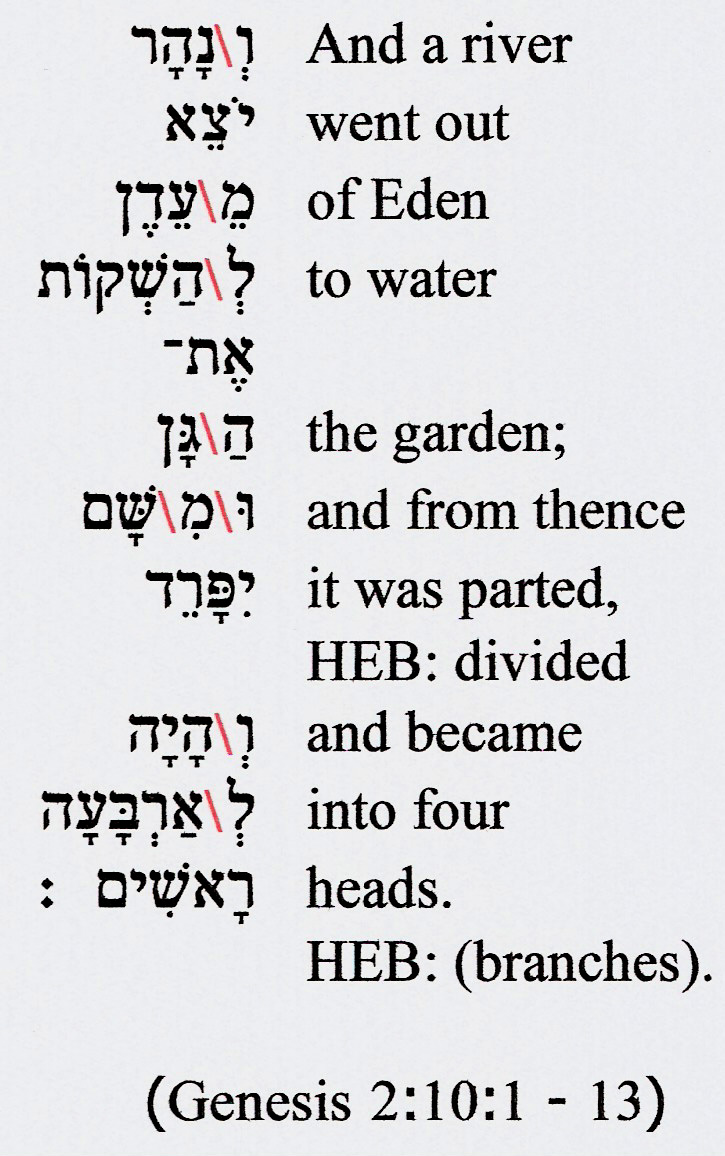|

LDS footnote b for
Genesis 2:10,
interprets “branches”.
The Hebrew word “rashim” (“heads”) actually appears in
the verse. The New Brown-Driver-Briggs-Gesenius Hebrew-Aramaic Lexicon
(B.D.B.G) notes: “river-heads
Gn 210”, pg. 911.
The Oxford English Dictionary (O.E.D.)
defines HEAD specific to a river as:
“16.
spec. The source of a river or stream. Now
chiefly in FOUNTAIN HEAD, q.v.”
The O.E.D. further indicates that this usage (“head” =
“source of a river”) goes back many centuries.
It is worth considering how the Hebrew verse above directly translates:
“And [a]
river proceeded from
Eden [Eden was a region not
just a garden] to irrigate [Hebrew direct object indicator
“et”,
is not
translated] the garden; and from there [Eden,
or the garden] he [the river,
masculine]
separated and was to four heads.” (Bereshit
(Gen.) 2:10)
In other words, each of the four rivers beyond the garden, had a source (at higher elevation) called a
“head”. There's no ambiguity here in the scriptural definition of a river’s
“head”. In
his vision of the Tree of Life, the Book of Mormon
patriarch Lehi clearly defines a river’s
“head” as it’s source from which it comes.
(1 Nephi 8:13-14)
This vision symbolically ties into Nephi’s
vision of the land of promise.
Heartland setting apologists assert that a river’s “head” could mean something else
in scripture. They impose a meaning
out of context.
In the context of a body (anatomy) a conflux of fluids may be termed a
“head”, but this is not how a river’s “head”
is defined.
A river’s “head”
is
simply
it’s source at higher elevation.
There are several rivers in the vicinity of
Adam-ondi-Ahman, Missouri which flow together, each
having independent heads, or sources at higher elevation.
The Mississippi / Missouri
confluence or
“mouth of the Missouri” was
never called the head of the
Mississippi. This confluence is not the head of
the Mighty Mississippi or the Missouri.(Wilford Woodruff's Journal, August 2, 1842, 2:184, see
also
History of the Church 5:56)
The Book of Mormon indicates that the land and city of Manti was
“by the head of the river
Sidon”.
(Alma 22:27) If we presume that the city of Manti was at
Huntsville, Missouri
(as Heartland setting proponents insist), and if we spuriously define any
confluence of rivers as the rivers’
“head”, then why would the mouth of the Missouri River uniquely qualify as the “the head of the river
Sidon”? Why not the confluence of the Des Moines
and the Mississippi just south
of Nauvoo? This confluence is actually closer to Huntsville
than the mouth of the Missouri!
If we seek a confluence of rivers even closer to Huntsville, there are several candidates.
There’s
the confluence of the Chariton and the Missouri.
Wouldn’t the Chariton be a more passable candidate for the Sidon river, even if, like the Mississippi, it flows in the wrong
direction?
(Alma 2:27-35,
43:35-40)
The Sidon river flowed northward on the east of Zarahemla from
“up”
by Manti in the south.
(Alma 16:6-7)
In Hebrew scripture, large and mighty rivers like
the Nile and the Euphrates qualify as “yamim”,
“seas”.
(Isaiah 19:5;
21:1,
Jeremiah 51:36; see B.D.B.G, pg. 411,
entry 6.) Doesn’t it makes more
sense to think of the Mighty Mississippi as a Nephite “sea”,
rather than a passable river like Sidon?
Actually it’s better to forgo the so called
“Heartland setting”
altogether and recognize the American heartland for what scripture says it is, “the south
countries” – south of Lake Erie.
(LDS D&C 75:8,
Mormon 6:15) Though the heartland is Book of Mormon territory, it is not where the principal lands of the Book of Mormon
(Nephi, Zarahemla, Bountiful etc.) are located. These situate near the
“west sea”.
(Alma 22:27-33)
Given the location of Cumorah in scripture
(LDS D&C 128:20), this
“west sea”
can only be Lake Erie.
Vincent Coon
כּוּן וִינְסֶנט
© Copyright 2013
|